Using the ZWO EAF for a Belt Driven Motorized Focusing of Canon Lenses
With this focusing will be fun and not a burden!It turned out as very convenient to use belts and pulleys from CNC and 3D printer parts in order to connect the ZWO EAF to the Canon lenses I currently use. This page describes what I found out.
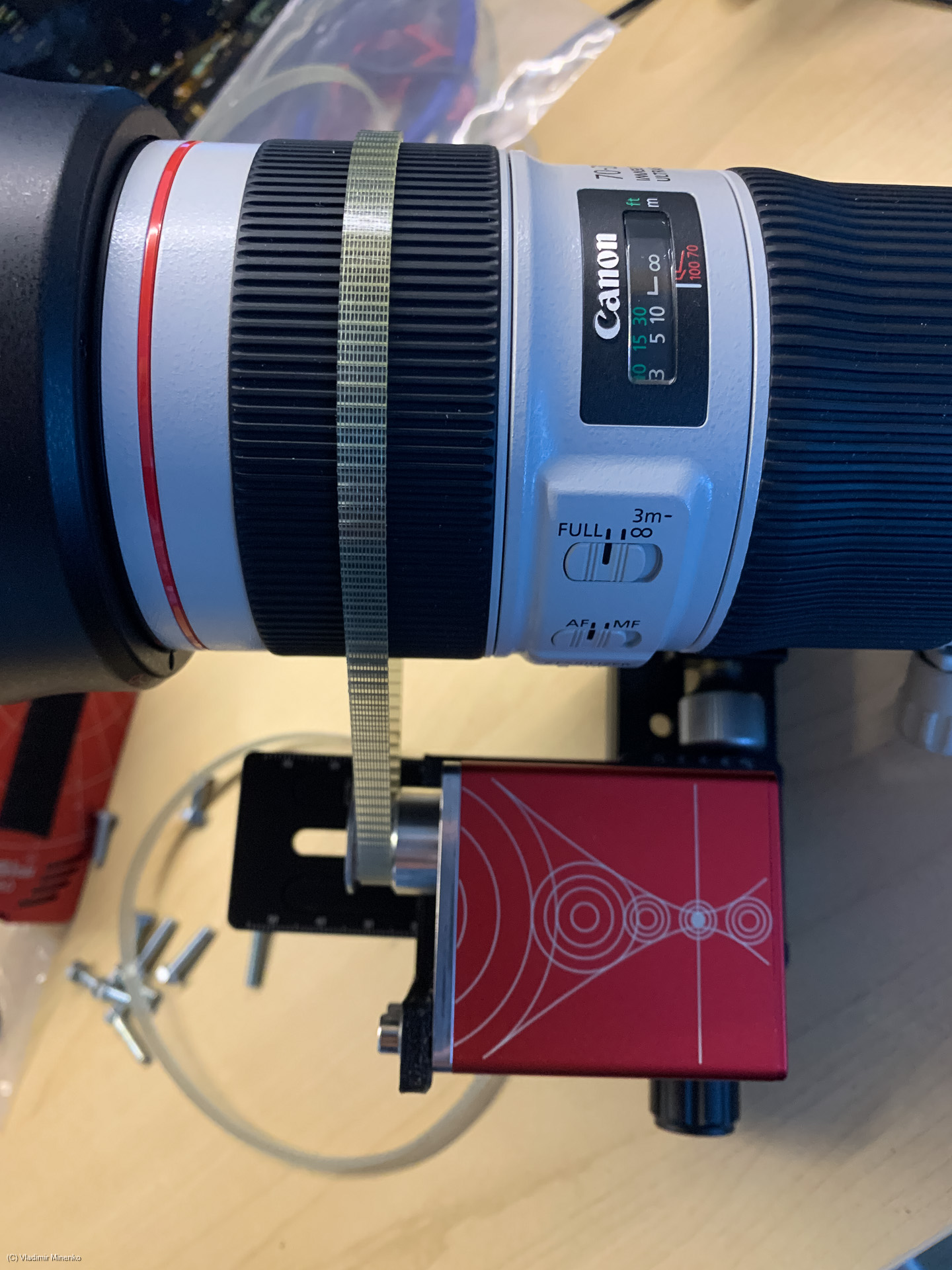
There are around a dozen of different drive belt profiles to select from. In order to find one, your first step is to find out the stepping of the rills on the grip of the focus ring on a lens. For the most Canon lenses I have, it seems to be 2.5-2.8mm. It is not very exact though, but it works since the grip provides enough surface friction. 2.5-2.8mm means that we can select the T2.5 profile. Along with the GT2 profile, the T2.5 profile is very popular. I strongly assume, this profile will fit with almost any lens, since a focus ring is easy to drive and the belt hold very well on the soft rills on the lens.
The second step is to decide which pulley to take. EAF has an axis of 5mm diameter. The pulley should be fixed on it with some clamping screws. It should not be too long, since that might cause twist tensions.
The choice of the pulley is also driven by the width of the belt. It is better to first find out which belts are widely available in local shops or on Internet and then look for pulley. For some reasons, the selection of belts is smaller than pulleys. The 6mm belts seem to be quite popular and would fit the needs well. The pulley on the EAF should be relatively small in order to provide appropriate transmission ratio. The EAF can rotate very slow. Still, a better translation will make focusing more granular. The control software of EAF in the AIRAIR just counts steps. The counter has limits, but they can be reset. If you use the optional hand controller, EAF can rotate endliessly. ASIAIR and the hand controller support two speeds. The “slow” one is really slow, but some transmission would be good. This means there are no firm requirement on the translation ratio.
Considering all that, I selected the timing pulley T2,5 6mm wide, 20 teeth, bore 5.00 mm H7 with clamping screws. The 5.0mm bore cooresponds the diameter of the axis of the ZWO EAF. Clamping screws and holes are an important detail too. Not all pulleys have that, but it is needed with the ZWO EAF. The mentioned pylley is available, for example, in the Dold Mechatronik Internet shop in Germany, see this link. I’m not sure they ship internationally. Please see if there are other places to order such a pulley in your country. Similar pulleys are avaialble from Asia, for example on Aliexpress.
There is a version of the same pulley with 16 teeth. That one will work well too and provide a bit higher transmission ratio so that more rotations of the EAF are required for the same change of focus as with 20 teeth. 16 teeth would be better for smaller lenses.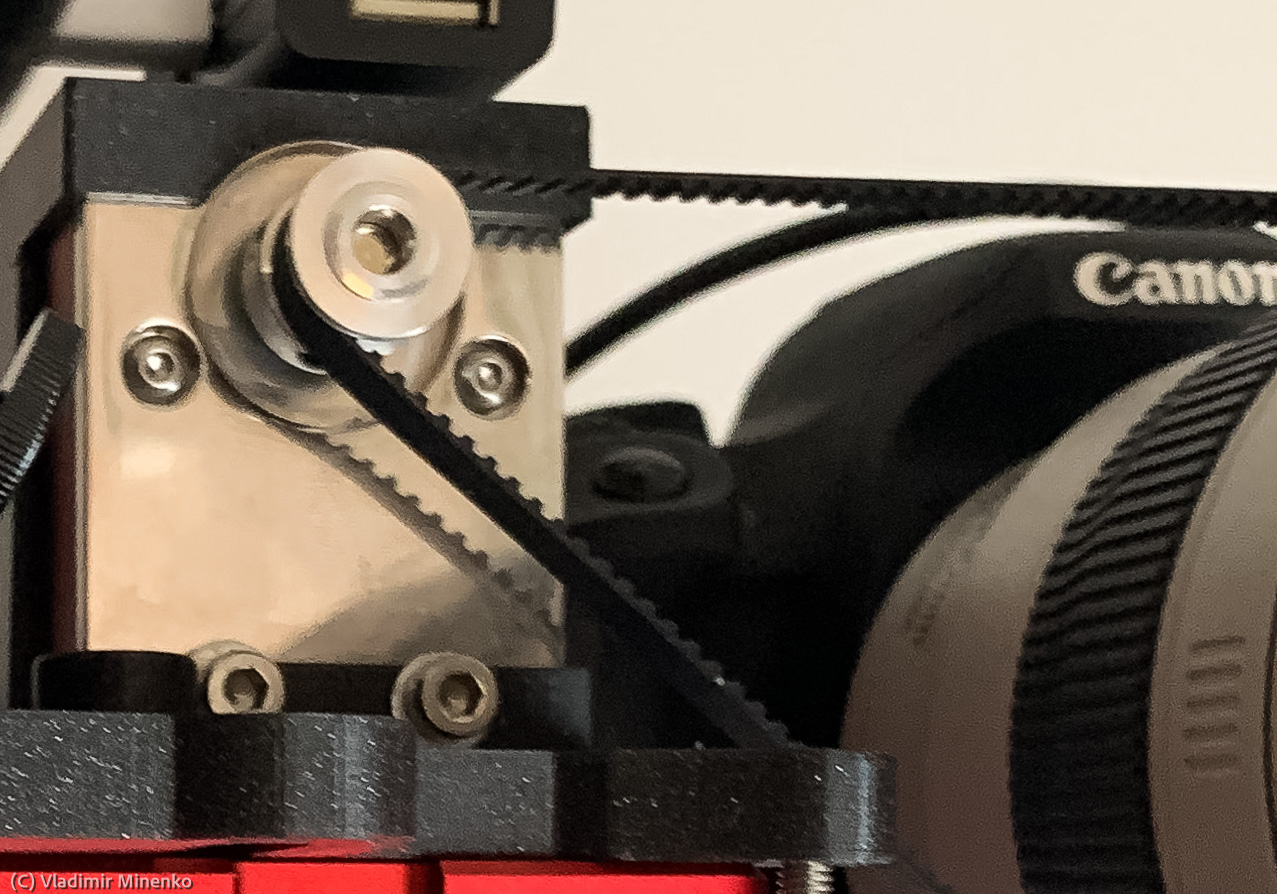
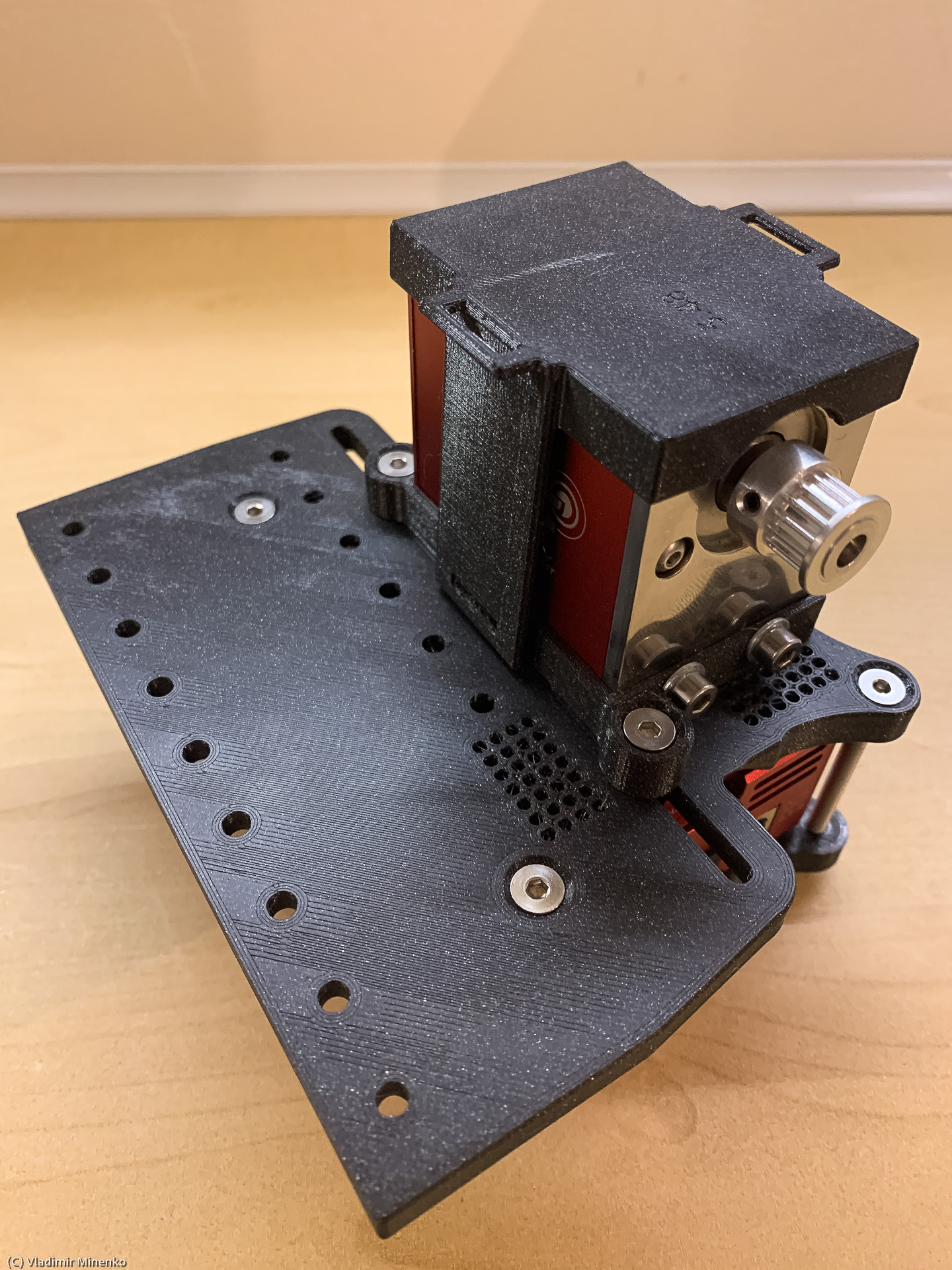
The next step is to find the belt. We already set the profile to be T2.5 and the width of 6mm. We need to find the size of the belt. The size of such belts is specified in their length which is the circumference of the imaginary circle the belt would layout. Finding the length of the belt seems to be one of standard tasks in the mechanical engineering. There are several tools to calculate this. The only major aspect to pay attention to is that a large amount of belts for CNC machines and 3D printer are not closed. The are sold in bulk rolls and later cut at a length as needed. We need a closed belt. When you search for a belt you might need another parameter – the number of teeth on the belt. The number of the teeth on the belt is not used in calculations, but some shop use it instead of the length.
Among other tools on the Internet, I found this page most convenient the calculation of the belt length. It is German, its nice drawing makes the formula clear without knowing any language. This site provides calculation help in English and in metric and inch units.
For this formula, we need to find measure the focus ring diameter and the diameter of the pulley. On the two lenses I used first, it is:
- Canon EF 100-400mm f/4.5-5.6L IS II USM : 93mm
- Canon EF 70-200mm f/4L IS II USM : 80mm
The 20 teeth pulley has the diameter of 15.4mm and the 16 teeth pulley – 12.3mm. Then we need the distance between the axis of EAF and the imaginary axis of the lens. This distance is also defined by the way how you want to mount the parts. It makes more sense to make an estimation and do not try to measure on the last mm, since you will need a way to slide component we achieve a good tension and this will make it possible to tune the distance as well.
I selected the belts by http://maedler.de of the following size:
- ST-P-T2.5 420 (168 teeth) – currently not used since it is too long in most cases
- ST-P-T2.5 380 (153 teeth) – used with Canon EF 100-400mm f/4.5-5.6L IS II USM
- ST-P-T2.5 330 – (132 teeth) – used with Canon EF 70-200mm f/4L IS II USM
- ST-P-T2.5 305 – (122 teeth) – currently not used since it is too short in most cases
The belts are also available from the Dold Mechatronik Internet shop in Germany, see this link. By time it turned out that I mostly used the 420mm belt and the shorter belts were too short and not needed. I meanwhile moved to use a 460mm belt and a 480mm belt with a larger camera, for example the Canon 5D mk4.
Belts made by http://maedler.de seem to be very durable and are apparently made for an extreme use in a CNC machine. Due to this they are slightly more expensive than average. There are more offerings on eBay and AliExpress. Most of them are made of a rubber-based material and have a better friction on the focus ring. If you have a choice just order 3-5 belts of different sizes from 330 to 500mm and see which ones works better.
One of the folks on the internet, mentioned on the forum, that focus rings seem to be sensitive for a constant pressure applied from one side over a long time. Considering this, it is better to take out the tension from the belt if it is not used:
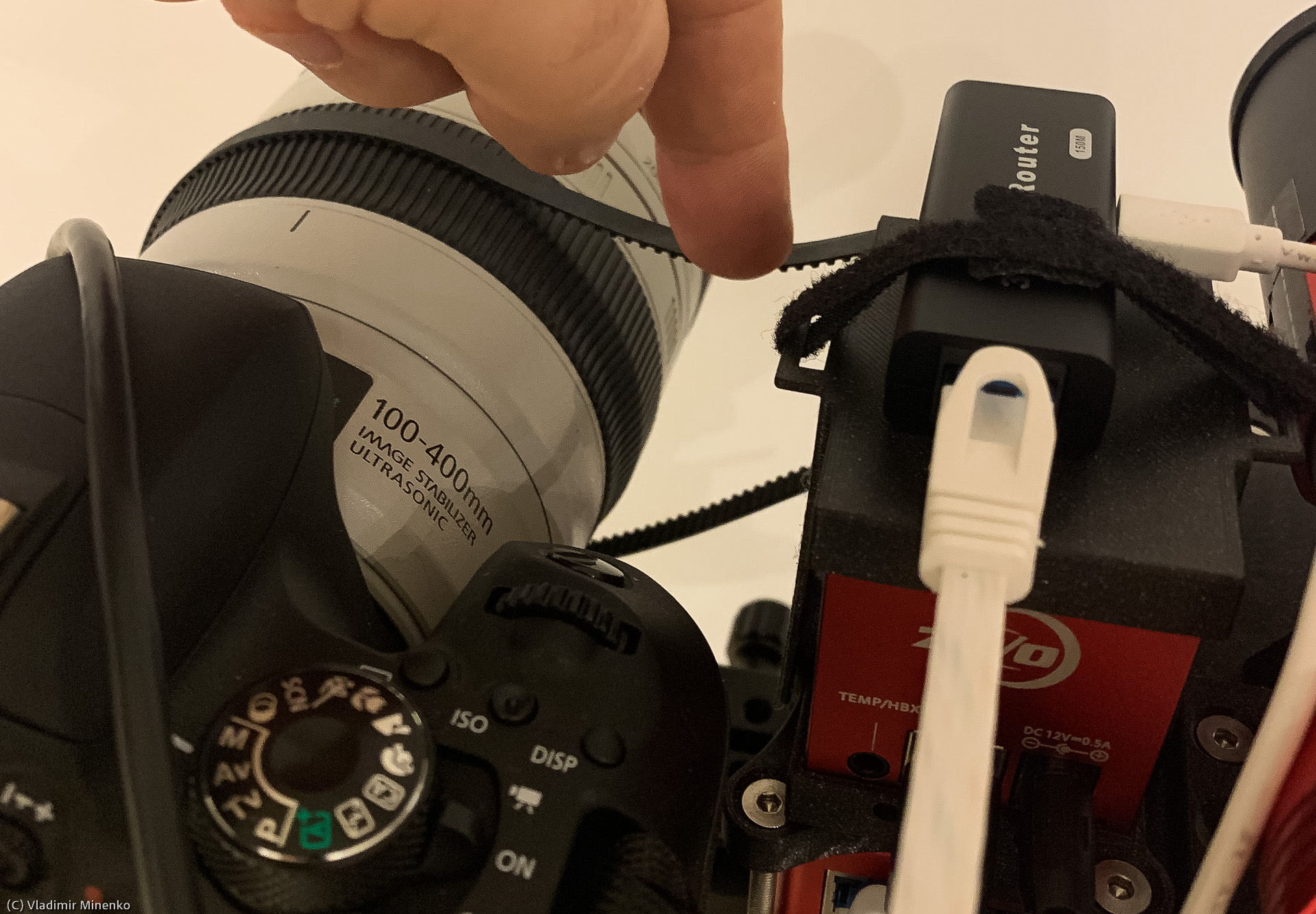
The above and the below picutres show my current DSLR setup based on the “Mounting set for ASIAIR Pro, EAF, a guiding scope, lenses and telescopes with a focus ring”.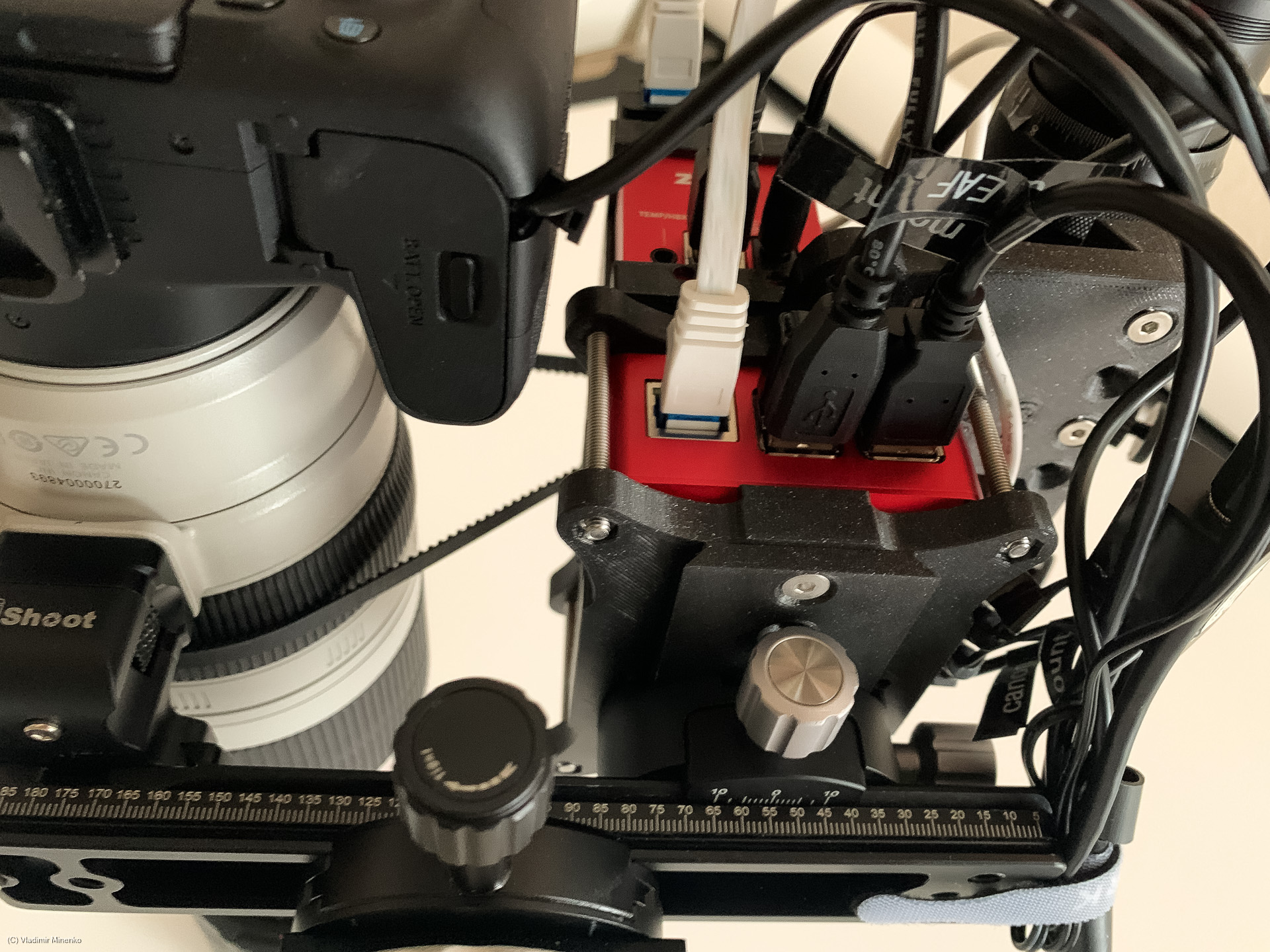 This kit makes trimming of the distances for different lenses easy, since the EAF and the camera can be moved along the mounting rails on the buttom
This kit makes trimming of the distances for different lenses easy, since the EAF and the camera can be moved along the mounting rails on the buttom
Hello Vladimir,
I would be very interested in your system.
I currently own a Star Adventurer and I use it with a Canon 7D MkII, a Canon 300mm 2.8, sometime a 1.4x extender, the AisairPro, Mini Guide scope and the ASI 120mm.
If I include the counter weight, my payload is close or slightly above the recommended 5kg.
My concern is that your brilliant system would add too much payload to an already heavy system.
My current set-up looks a bit like this https://www.star-watcher.ch/equipment/my-setup/, or this https://www.star-watcher.ch/equipment/my-mobile-observatory/.
How much is the weight of your device (screws, plates, brackets…).
Thank you for your answer
Assuming you just what to add a motorized focuser, then I believe the additional weight should not be of a big concern. The ZWO EAF weights around 270g. This is the heaviest part. The pictures of the setup on this page also shows brackets and rails which I do not use much anymore, since I use the https://minenko.org/mounting-set/. I guess they weight not more than 100g. The heaviest part in that portion would be the iShoot arca-swiss plate, I guess, around 50g. You can see it better on this picture:
https://minenko.org/astrophotography-equipment-gallery/gallery/page/2#gallery/a96fe04735ffa54fda8afbcfbe5235d8/587
It is on the right side. The picture shows my old setup which I do not use anymore. The largest “challenge” at this time was to make a holder for the EAF which would make it sit on an acra-swiss rail. I should have a 3D-print design for such a holder. I plan to share it by time on https://www.thingiverse.com/
One thing is clear though. Surprisingly, a motorized focusing makes a lot of sense on portable setups which are not so stable and stiff like ones placed on a real mount like EQ6-R or similar. Plus, manual focusing a telephoto lens is much more difficult than focusing a telescope. This is the right direction to invest in improvements.
Vladimir,
I was looking into how to adapt the EAF to my Canon 500mm lens and found your page. Thanks for the helpful info.
– I use Mac computers. Would it be relatively easy to control the EAF you think?
– I’m considering using the ASIAIR+ too. Have you used it for autofocusing and/or doing a focusing procedure to find the best focus?
– From your text, it appears the EAF has no encoder, correct? Any comment for correcting focus during the night w/o a positional readout as a guide?
Thank you!
Hello Antonio,
I’m also using macs most of the time. When I started, I thought I would use my macbook for image capturing and control. The best site which I found to start was https://www.macobservatory.com . Short after, I started to use ASIAIR, since I did not want to setup an entire office in the field 😉 For now, I use ASIAIR only and use my macs for image processing only.
Yes, I use ZWO EAF in all my setups. This https://minenko.org/mounting-set/ was made for universal use with DSLR lenses. I also have one for my RC8 (https://minenko.org/photastro/zwo-eaf-for-bds/) and for Sky-Watcher Esprit 100ED (https://minenko.org/photastro/esprit-100ed-mounting-kit/)
In my experience, you can make ASIAIR and EAF working with any focuser, including autofocus. It is just a matter to find the right gear ration and tune the focuser steps setting in the EAF setting in ASIAIR.
EAF has an encoder. You can change it position step-wise and do a “go-to”. IIRC, it has 65K steps for one full rotation. You can configure an automatic start of a new autofocus run upon different events in ASIAIR, e.g.on filter change, each hour, or if the temperature changes by 5 or 10 deg. It is not possible to run that as a “correction”. It always runs as a new full cycle of autofocus. It is generally not a problem, since it takes one or two minutes.
Hello Vladimir,
Thank you for your important comments. Good do know that the ASIAIR + EAF combo works well. Will order the ASIAIR now. Yes, it definitely beats having a laptop outside.
Thanks for all the info you provided on your pages.
Best.
As far as belts go you can make your own custom length. Just buy some bulk belt material or a belt longer than you need. Cut the belt to the proper length and splice it together with super glue. you have to cut it properly so the teeth match up. I have done this for several of my DIY auto focusers and they have never broken. I always have spare belts on hand.